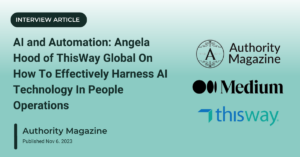Automation and digital transformation are everywhere we turn, and that’s not by mistake. In 2018 and 2019, organizations were talking about how disruptive it would be to make such a transformation.
Fast forward to today, not discussing automation at all could leave your business in the dust. Business owners are taking heed and the initiative to automate the processes in their businesses from the top down.
In fact, 70% of businesses are either working on an automation strategy or already have one in place.
As this number grows, we see the C-suite executive offices evolving to keep up with the times. New positions are being added and one position making the most headway is the Chief Automation Officer.
What is a Chief Automation Officer?
Until the creation of the Chief Automation Officer (CAO), automation and the use of artificial intelligence was a responsibility given to the Chief Information Officer (CIO) or shared with other IT executives.
Once automation graduated from a way to save organizations money to a necessity to operate in the current business climate, that responsibility became too cumbersome to be merged with another executive.
Utilizing automation throughout your organization is hearty enough to be overseen by its own executive – the CAO. Establishing a CAO empowers the CIO and other IT executives to focus solely on new technologies to support the organization.
Remember when we had to scramble to transition to digital technology during the pandemic?
We implemented platforms and software as we saw fit and sometimes on a project-by-project basis. Well, CAOs don’t work in that fashion.
They develop a viable strategy and roll it out at a scale suitable to your organization. The strategy can include software, technology, machines, artificial intelligence, and even the use of robots. The primary goal is to integrate automation seamlessly into everyday operations.
What falls under a CAO’s scope depends on the industry and nature of the business. It could be as complex as application development and robotics or analyzing the organization for outdated and manual processes to automate.
A key component of their job is staying up to date with the latest trends and reacting quickly if it’s something the company can benefit from.
Measuring the performance of the new processes put into play is another essential task for the CAO. They must determine the KPIs (key performance indicators) and analyze the data to make actionable decisions.
Everything a CAO does should ensure that business functions and automation operate in tandem, including the people using them. This is a crucial point and a deliberate effort.
CAOs must maintain a balance between the human element and automation. It’s not about machines possibly taking the employees’ jobs; it’s about making their job better and the employees more successful at doing it.
The Fabric of a Chief Automation Officer
To be a CAO, it takes someone who’s passionate about the organization’s overall operational success and not afraid to make a change. Remember, their primary goal is to integrate AI and automation with business operations and employees harmoniously.
The qualifications you’d want to look for in a CAO are a strong background in technology, business process management, and a master of data management. They should always be on the hunt for innovative ways to better operations.
A CAO should also have expertise in several areas of automation:
- Workload Automation
- Batch Process Management (BPM)
- Big Data Automation
- Robotic Process Automation (RPA)
- Integration Automation
That’s just to name a few, but there are other areas in which they could have substantial knowledge.
There is another side to being a CAO. As with any C-suite executive, they have to keep the stakeholders in mind and are expected to show their value. Fortunately, that’s where the KPIs and analytics mentioned above come in handy to show and prove their worth.
With the ability to work with all C-suite executives and departments to carry out their goals, their worth can be far-reaching.
Cross-Department Functionality
Maneuvering across multiple departments is vital to the success of not only the CAO but the company as a whole. Depending on the industry and type of business, you’re liable to see the CAO work closely with the Chief Human Resources Officer (CHRO) to maintain the balance between human resources, automation, and AI.
HR, in general, is going through one of the most extensive digital transformations, so it makes sense to have the prowess of a CAO.
The last two years have been nothing short of a roller coaster ride for HR; between the labor shortage, Great Resignation, and inflation, HR has witnessed a myriad of bad days.
As the events unfolded, it created a real need to hire qualified candidates, slow the employee attrition rate, and improve the hiring process. For businesses finding themselves in this predicament, the CAO can start by focusing on improving HR.
The CAO can assist with recruitment solutions, automate candidate sourcing, and other tasks.
For example, if HR is overwhelmed with candidate sourcing and missing out on qualified candidates, the CAO may implement a platform like IBM Watson OrchestrateTM. The company’s HR professionals would be given a digital assistant, digey, to take over those tasks for them.
To ensure qualified applicants don’t slip through the cracks, the CAO may create another solution using AI to help screen resumes if HR is inundated with an influx of applicants.
Just imagine the improved work-life balance achieved if recruiters can automate the talent-sourcing process. Now the recruiter can spend less time sourcing qualified candidates and more time doing what they do best… engaging with candidates!!
The CAO may also implement recruitment software to increase the number of candidate profiles and speed up the candidate screening process, ultimately incorporating the use of artificial intelligence (AI) in HR.
Showcasing how the CAO can holistically combine automation with the people in the organization.
The Benefits of Having A CAO
Artificial intelligence and automation will continue to integrate with our businesses as we move further into the digital age, especially in the workplace. Having a specified role to handle the challenges, changes, and management of automation can keep the organization up to par or above the competition.
Your business running like a well-oiled machine is just one of the benefits of having a CAO. They can also make you more attractive to top talent.
Not the position of the CAO itself, but the automation and AI they implement can appeal to the younger generation that’s entering the workforce, Generation Z. This is the first completely digital generation. They have different expectations of what work-life balance looks like, and it starts with not doing everything manually.
Outside of attracting qualified candidates, the CAO has the potential to increase the retention of current employees, as well as slow employee attrition rates, by assisting employees with their workload and improving cumbersome processes.
Even if your business isn’t ready to develop a C-suite-level CAO position, it’s worth looking at how automation and AI can enhance your business functions. Research and experiment with new technologies to see what fits your organization.
Don’t get left behind in the age of artificial intelligence and digital transformation.
Going through a digital transformation doesn’t have to be daunting. Using ThisWay’s product suite to improve your talent-sourcing process is a great way to get started or enhance your existing recruitment system.
Ready to automate your HR processes? Come see how easy automation can be, ThisWay!









